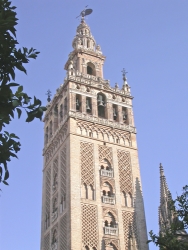Seville
Though located inland,Seville, the cultural and financial
capital of southern Spain, was once an important seaport. The
Guadalquivir River, which crosses through the region, was navigable
up to Cordoba throughout the Middle Ages, but over time silt
accumulation has made it impassable beyond Seville.
Much of the city's architecture reflects centuries of Moorish
culture, which ended in 1248 after Ferdinand III of Castile gained
control. Moors began building the Alcazar of Seville in 1181, and
construction continued throughout the next 500 years. Today the
fortified palace serves as the Spanish monarchs' official
residence.

Seville Cathedral
Construction of the Cathedral of Seville, the largest Roman
Catholic cathedral in the world, spanned the 15th century. The
central nave soars to a breathtaking 42 metres and adjacent chapels
are large enough to contain a typical church. Gold accents abound
in the lavish interior décor and Pierre Dancart, a Spanish wood
carver, devoted his life's work to creating the 45 Gothic scenes
from Christ's life displayed in the Capilla Mayor. The cathedral's
Giralda bell tower has grown to become a symbol of the city.
Solemn yet beautiful processions held during Easter holy week,
or "Semana Santa", are quite captivating. The poignant atmosphere
often moves even the non-religious. A colourful fiesta celebration
replete with flamenco music and dancing, horsemanship displays and
traditional Spanish dishes follows a few weeks later. Its appealing
culture and deep historic and religious roots draw scores of
visitors to Seville each year.